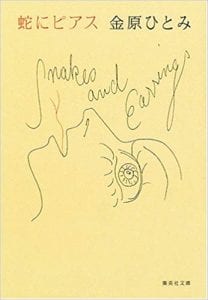Kanehara Hitomi 金原ひとみ. Hebi ni piasu 蛇にピアス. 2003.
Co-winner of the 130th Akutagawa Prize, for the second half of 2003.
A nineteen-year-old clubgoing girl, Rui (or Lui), meets a clubgoing punk guy, Ama, and falls in love with his split tongue. She’s really into ear-piercing, and right away decides she has to do a split tongue. It starts with a piercing, and one thread of the plot is following the progress of this piercing as she widens it until she’s ready to split what remains of the end of her tongue. Through Ama she meets Shiba, the piercer and tattooer, and she falls in love with his kirin tattoo; she ends up getting a tattoo on her back of a dragon (like Ama’s) intertwined with a kirin. This mirrors her love life: she’s kind of stumbled into living with Ama, although she can’t decide if she really loves him; meanwhile, she’s having sadomasochistic sex with Shiba, whose S complements her M, and who’s a contrast to Ama’s surprisingly conventional ways. The third plot thread is murder: one day a yakuza type starts to grope Rui in the street, and Ama beats him to death. The cops are looking for Ama, but in the end somebody else gets to him first: he’s found dead in the harbor. At the end of the book, though, the cops conclude that he’d been raped and abused, and some of the clues they found make it seem to Rui highly likely that it was Shiba who did it, either accidentally (maybe Shiba and Ama had been secret lovers) or out of jealousy. This sort of shocks her – in her depression she’s moved in with Shiba by this time – but it snaps her out of her depression, and the story ends ambiguously. She has Shiba paint the eyes in on her tattoo, something she’d asked him not to do earlier, and this sort of symbolizes how she snaps out of her funk and determines to go on living. No signs of leaving Shiba.
Obviously, it has some of the flaws of junbungaku (“pure” or high literature: one of the functions of the A-Prize is to define what is and isn’t this) – leaving it unresolved is just as much of a trick as resolving it in some way, and in junbungaku it’s a cliché. On the other hand, it’s well-written – first person (that goes without saying in junbungaku, doesn’t it?), and not as dedicated to reproducing a subculture’s speech patterns as, say, Mobu Norio, but more so than Wataya Risa, and still you get a good sense of this girl’s personality. Which is, she’s kind of in a daze – when Ama is gone she realizes they had been living together for months but never even knew each other’s full names. She’s a borderline alcoholic. She says she has a reasonably good relationship with her parents, but is only fairly sure she knows where they live.
The tattooing and piercing are the key here. She reflects at one point that they’re like a shelter, a cover – they seem like incredibly attention-drawing and public acts, but since people immediately judge her and reject her for them, they create space for her to think and be herself without society’s interference. A way to live outside the law, as Dylan would say. So in a sense we’re back in subculture territory here.
It’s a feminist self-realization quest, too: she’s consciously making over her body how she wants it, she’s constantly being called a gyaru by others and insisting that she’s not, she’s torn between love for these two guys and resistance to their urge to possess her. The unresolved ending is, of course, a resolution of this: by choosing to live, she’s finding her self, finishing her tattoo, taking charge of her life.
The specifics of the subculture are interesting. The S&M stuff isn’t shocking, as it’s been appearing in J-lit for at least a couple of decades now, although Yamada Eimi never won the A-Prize (I wrote a paper in grad school on S&M in the works of Murakami Ryû and Yamada Eimi; maybe I’ll summarize it here someday: interesting topic, at least). The piercing might be new to A-Prize level lit, I’m not sure. The tattoo is interesting because of Tanizaki’s old tattoo story; Kanehara seems to be consciously echoing it.
A real good one. By the way, this one’s been translated; I haven’t read the translation, so I can’t comment on it.
